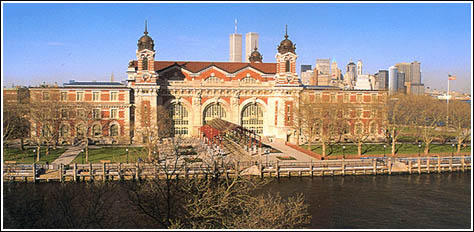The Ellis Island Project: Successfully Preserving Americaís Immigrant History
Introduction

Image from http://www.ellisisland.com/indexInfo.html

In the past two centuries, it appears that the need to preserve and protect our countryís stories and histories from becoming forgotten or wrongly remembered has become more prevalent within our culture. Because we have a diverse immigrant history, individuals, such as Peter Sammartino, and institutions, such as the Statue of Liberty--Ellis Island Foundation, determined that it was necessary to preserve elements of this history, including Ellis Island. For many of the immigrants who passed through Ellis Island and their families, as well as other Americans, this port of entry retains special meaning. Although immigrants in the early part of this century could enter the United States through several points, such as Boston and San Francisco, the most famous was Ellis Island. Between 1892-1954 over 12 million immigrants entered America through this point: over 40 percent of Americans living today can trace a relative back to Ellis Island.
Once a decision had been made to preserve parts of Ellis Island, millions of dollars had to be raised to preserve and rehabilitate key buildings and to construct a museum dedicated to immigration. Careful consideration and planning was required in undertaking such a large project that was so meaningful to so many Americans. Raising the large sums required for such a mammoth project was challenging; in addition presenting the many diverse issues relating to immigration in an unbiased manner was problematic. Enormous sums were raised for the preservation and restoration of the decrepit Ellis Island facilities and for the museumís construction, but controversies such as the legality of the fund-raising, as well as criticisms of the museum have arisen over time. (Holland 3) The Statue of Liberty--Ellis Island Centennial Commission and The Statue of Liberty--Ellis Island Foundation were the two official groups responsible for fundraising, restoration, and preservation. Click here to find out more about The Statue of Liberty--Ellis Island Foundation. I found several issues that I feel are relevant and important. First, there were questions concerning which group or groups would be responsible for fundraising. Second, was deciding which methods would be used for raising money; with a related issue being the need to ensure that no illegal fundraising activities were used. Finally, assurance was needed that major contributors were not permitted to distort the exhibits to reflect their views which could have jeopardized the museumís integrity.
Despite these challenges, the Statue of Liberty--Ellis Island fundraising project was one of the most successful ever undertaken in America due to careful planning, consideration, and decisive actions. Most of the funds that were raised were used to restore parts of Ellis Island--including repairs to the sea wall and selected buildings. In addition, funds were used to establish the Ellis Island Immigration Museum which was installed within existing buildings. Click here to go to the Ellis Island Immigration Museum website The museum, like the fundraising project, was also extremely successful. It has accurately depicted the story of immigration: past, present, and future, and enlightened many viewers. This success was due to careful planning, consideration, and decisive actions. It stands out as a exemplary museum, dedicated to preserving the stories and histories of immigrants as well as the island itself with a well-balanced view, attracting many visitors in the process. Despite these successes, however, there are some ways that the museum could be improved to better enlighten and educate its visitors.
Click Area of Interest:
Ellis Island Introduction
History of Ellis Island
Immigration Experience
Preserving Ellis Island
Ellis Island Museum
Research Family History
Reference Page